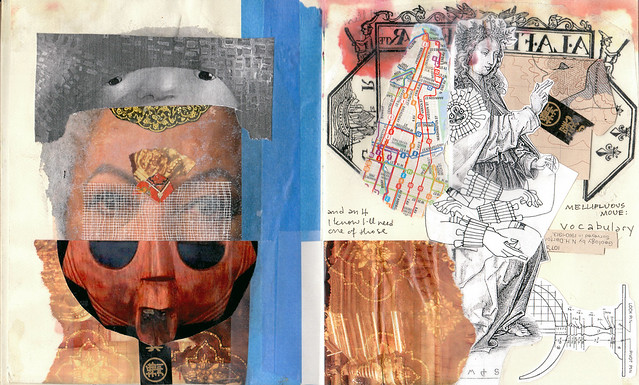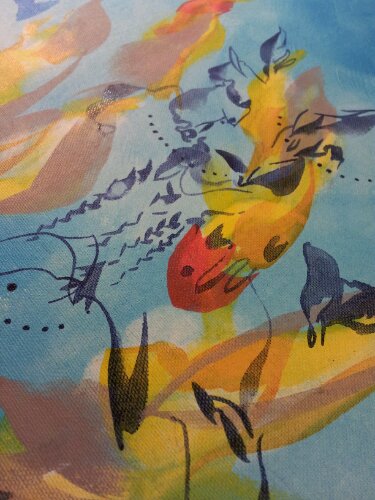The Creative Genie
Elizabeth Gilbert, author of Eat Pray Love, talks about the mysteries and frustrations of the creative process. Below the video is a sampling of free associations from when I watched the video myself.
03:50 "Somehow we've completely internalized and accepted, collectively, this notion that creativity and suffering are somehow inherently linked. And that artistry, in the end, will always ultimately lead to anguish. ...I'm not at all comfortable with that assumption. I think it's odious, and I also think it's dangerous. And I also don't want to see it perpetuated into the next century."
Fortunately, in this 'next' century, we are seeing an increasing awareness and encouragement of the creative class, and of makers in general.
I remember my Dad, the artist. He was creative in many areas of his life - gardening, cooking, pottery, weaving, calligraphy, teaching, raising a daughter. He tried many things, and never restricted himself to a single medium.
Origins of the words "Genie" and "Genius"
Genie "mid 17th century (denoting a guardian or protective spirit): from French génie, from Latin genius (see genius). Génie was adopted in the current sense by the 18th-century French translators of The Arabian Nights' Entertainments, because of its resemblance in form and sense to Arabic jinni 'jinnee'"
Genius "late Middle English: from Latin, 'attendant spirit present from one's birth, innate ability or inclination', from the root of gignere 'beget'. The original sense 'spirit attendant on a person' gave rise to a sense 'a person's characteristic disposition' (late 16th century), which led to a sense 'a person's natural ability', and finally 'exceptional natural ability' (mid 17th century)"
09:25 "There's probably people in this audience who would raise very legitimate scientific suspicious about the notion of, basically, fairies who follow people around, like, rubbing fairy juice on their projects... Why not think about it this way? Because it makes as much sense as anything else I have ever heard in terms of explaining the utter, maddening capriciousness of the creative process."
That Thing
11:57 "I'm not the pipeline. I'm a mule. And the way that I have to work is that I have to get up at the same time every day and sweat, and labor, and barrel through it really awkwardly. But even I, in my mulishness, have brushed up against that thing."
That thing, I've felt it. A quickening of the pulse, a brush with a tangent universe in which my painting is finished and brilliantly realized. I can suddenly see where I need to go.
Because That's My Job
But it doesn't come all at once, except perhaps once every great while. I have to get up at the same time every day and go into the studio and work. I work to be workful. I pursue relaxed concentration.
How lucky the students of University of Wisconsin - Madison are to have the chance to take Lynda Barry's next class! The Unthinkable Mind will be "A writing and picture-making class with focus on the basic physical structure of the brain with emphasis on hemispheric differences and a particular sort of insight and creative concentration that seems to come about when we are using our hands (the original digital devices) to help us figure out a problem." Sadly, I am not a student at UW, but I hope that Ms. Barry will share her students' work on The Nearsighted Monkey like she did for the What It Is class.
14:58 "So I just lifted my face up from the manuscript and I directed my comments to an empty corner of the room, and I said aloud, 'Listen, you, thing. You and I both know that if this book isn't brilliant, that is not entirely my fault, right? Because you can see that I am putting everything I have into this. I don't have any more than this. So if you want it to be better, then you gotta show up and do your part of the deal, okay? But if you don't do that, you know what? The hell with it. I'm going to keep writing anyway because that's my job."
What does my genie look like?
I thought of Technical Boy from American Gods by Neil Gaiman. Also, Tavi Gevinson.
And, coincidentally, The Oatmeal's take on being a content creator (whole comic very much NSFW):
"Art is not born in a vacuum, but it's not born inside a tornado full of shrieking trolls, either."
Mellifluous Moue Collage Sketch

Mellifluous Moue sketch & mask collage, mixed media sketchbook pages, 2009 by Sarah Atlee. Some rights reserved.
Collage sketch for Mellifluous Moue, Patron Saint of Vocabulary.
Here’s the final drawing:
WordPress Tip: Hire Jason Ormand
 LIÁN TYPES »Reina« No.1 | white on black by Flickr user arnoKath. Click image to view source.
Jason Ormand knows that great design makes the world a better place.
LIÁN TYPES »Reina« No.1 | white on black by Flickr user arnoKath. Click image to view source.
Jason Ormand knows that great design makes the world a better place.
Sarahatlee.com has been on the air for eleven years. It's gone through many design iterations, some that I created myself, more done with the help of web design pros.
Division of Labor
In recent years I have learned that I am not the person best qualified to design and maintain my own website. I could learn to become so, but I already have a job as a full-time artist.
Turning sarahatlee.com over to professional web designer Jason Ormand is one of the best investments I have ever made. Jason shares my penchant for clean, elegant design, and he has a fine-tuned understanding of how people interact with the web.
I asked Jason to tell us a little more about what he does for a living.
When people ask, "So what do you do?" how do you answer?
I’m a Web Designer and Front End Developer.
How did you get into this business?
In 2007, Windows “automatically fixed” an external hard drive that I used to store all of the photos from my various adventures while I was in the Navy. Windows reformatted my hard drive and I lost 4 years of photos. Later that same day I was installing Linux on my laptop. That snowballed into an insatiable thirst for all things computers. I was building websites within a month.
What do you love about good design?
Clarity. Making a web site aesthetically pleasing while staying laser focused on the primary goal.
What do you hate about bad design?
Failure to communicate. If visitors are confused, it’s very unlikely that they will succeed at their task. If their task was to buy something from you or find your contact page, you lose.
Do you have a dream job, other than this?
This is my dream job. I love what i do.
Dude, are you for hire?
Yes. I’m currently accepting new projects. Interested parties can go to JasonOrmand.com/contact, where they can find the various ways to contact me.
Thanks, Jason.
Wrangling Those Blog Post Ideas
 I Miss Oklahoma, ink on paper, 2009 by Sarah Atlee. Some rights reserved.
I Miss Oklahoma, ink on paper, 2009 by Sarah Atlee. Some rights reserved.
I'm learning in the Blog Triage course that ideas beget other ideas. How to keep track of them all?
Following is a cross-section of my own blog-writing process.
Ideas are slippery. Capture them.
If I get an idea for a post and I'm not at the computer, I write it down in in my Hiptser PDA. Then I say to myself, "Captured - huzzah!"
Since my Hipster is a series of to-do lists, incomplete tasks stay on top until done. Post ideas stay on top until I store them in the Blog directory on my flash drive, which I carry everywhere.
Ideas want to wander. Park them.
At the computer, I open a new file in a plain-text editor (NoteTab or TextWrangler) and type in one or two sentences describing the idea. Example: "Flat Stanley, cheap markers."
I save the file with the date in ISO 8601 format. Example: "20120501 flat stanley cheap markers.txt"
Because computer operating systems like to sort files alphabetically by default, this date format automatically keeps files in chronological order. Handy.
In a web browser window, I open all the web pages that relate to my post in separate tabs. Oh, how I love tabbed browsing! Each url gets copied and pasted at the bottom of my plain text document. This is just to park them until I turn them into links.
Maybe this won't turn into a post today. I move the plain text document into a subfolder on my flash drive called "unpublished." It's a great place to go back and browse when I'm looking for new content for my blog.
Now, to the WordPress dashboard. I create a new post, put ONLY the title in, and save it as a draft. It is very important that I do not fiddle around with any of the shiny WordPress buttons at this time.
Ideas want to be polished.
Back in NoteTab, I finish composing my post.
Using the bits of html code that I know, I put all the link URLs into place.
I run through my preflight checklist, checking all links, spelling and grammar, and taste-testing for maximum zestiness.
I copy and paste the whole text into WordPress. I save the draft again (!) and preview it to check my links again (!).
Then, and only then, do I click "Publish."
Last step: eat some chocolate and go to bed.
Are you having trouble deciding what to write, or how to write it?
Keep your eyes peeled for Alyson Stanfield's next Blog Triage workshop.

